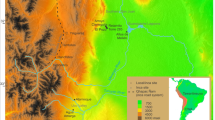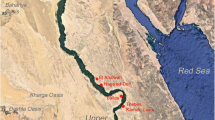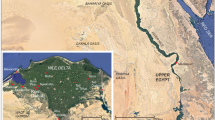Abstract
Forty-three pottery samples from the New Kingdom site at Amara West in Nubia (Sudan) were analysed by optical microscopy and scanning electron microscopy-energy dispersive X-ray spectrometry to identify pottery potentially produced at the site. Twenty-two samples from modern local alluvial soils, modern locally made pottery and archaeological material (mudbricks, daub, oven liners and kiln fragments), likely to have been made from locally sourced clays, were also studied. The analytically and microscopically defined pottery fabrics were cross-correlated with macroscopic fabrics defined on-site during fieldwork to demonstrate not only the potential and limitations of both approaches but also how the complementary datasets can provide new insights. The mineralogical and chemical analyses, of 65 samples, suggest that locally manufactured pottery included both Egyptian-style tableware and Nubian-style cooking pots. At the same time, the community at the site imported ceramics from a variety of different regions, including Egypt itself.










Similar content being viewed by others
Notes
For more details on the macro-fabric description, see Millet (forthcoming).
One reviewer commented that fully quantitative trace element data were required to separate Nile clays from different sources in Egypt and, therefore, that it is possible that some of the sherds in groups 1–4 are non-local; we are unable to reject this suggestion with the existing data, but we think it is highly unlikely that more than the occasional sherd in groups 1–4 was imported.
References
Aston D (1989) Qantir/Piramesse Nord: Pottery report 1988. Göttingen
Aston D (1996) Egyptian pottery of the Late New Kingdom and Third Intermediate Period (twelfth-seventh centuries BC): tentative footsteps in a forbidding terrain. Studien zur Archäologie und Geschichte Altägypten 13. Heidelberg
Aston D (1999) Elephantine XIX. Pottery from the late New Kingdom to the early Ptolemaic Period. Archäologische Veröffentlichungen 95. Mainz am Rhein
Aston D (2008) Untersuchungen im Totentempel des Merneptah in Theben. IV: The pottery. Beiträge zur aegyptischen Bauforschung und Altertumskunde 17. Mainz am Rheim
Bavay L (2004) Du tesson à l’histoire économique. Perspectives nouvelles sur la céramique du Nouvel Empire à Deir el Médina. Egypte Afr Orient 36:21–30
Binder M (2011) The 10th–9th century BC—new evidence from the Cemetery C of Amara West. Sudan and Nubia 15:39–53
Binder M, Spencer N, Millet M (2011) Cemetery D at Amara West: the Ramesside Period and its aftermath, British Museum Studies in Ancient Egypt and Sudan 16, http://www.britishmuseum.org/research/online_journals/bmsaes/issue_16.aspx
Bourriau J (1998) The role of chemical analysis in the study of Egyptian pottery. In: Eyre CJ (ed) Proceedings of the Seventh International Congress of Egyptologists, Cambridge, 3–9 September 1995. Orientalia Lovaniensa Analecta 82, pp 189–99. Leuven
Bourriau J (2001) The role of chemical analysis in the study of Egyptian pottery. In: Shortland AJ (ed) The social context of technological change. Egypt and the Near East, 1650-1550 BC. Proceedings of a conference held at St Edmund Hall, Oxford 12-14 September 2000. Oxbow Books, Oxford, pp 189–199
Bourriau J, Smith LMV, Nicholson PT (2000a) New Kingdom pottery fabrics. Nile clay and mixed Nile/Marl clay fabrics from Memphis and Amarna. The Egypt Exploration Society, London
Bourriau J, Nicholson P, Rose P (2000b) Pottery. In: Nicholson N, Shaw (eds) Ancient Egyptian Material and Technology, pp 121–147. Cambridge
Bourriau J, Smith L, Serpico M (2001) The provenance of Canaanite Amphorae found at Memphis and Amarna in the New Kingdom. In: Shortland AJ (ed) The social context of technological change. Egypt and the Near East, 1650-1550 BC. Proceedings of a conference held at St Edmund Hall, Oxford 12–14 September 2000, 189–199. Oxbow Books, Oxford
Bourriau J, Bellido A, Bryan N, Robinson V (2006) Egyptian Pottery Fabrics: a Comparison between NAA Groupings and the “Vienna System”. In: Czerny E, Hein I (eds) Timelines. Studies in Honour of Manfred Bietak. OLA 149, pp 261–92. Vienna
Carrano J, Ferguson JR, Girty GH, Smith ST, Carrano CJ (2008) A chemical and mineralogical comparison of Nubian and Egyptian style ceramics and the implications for culture contact: preliminary report, Sudan & Nubia 12:90–98
Carrano JL, Girty GH, Carrano CJ (2009) Re-examining the Egyptian colonial encounter in Nubia through a compositional, mineralogical, and textural comparison of ceramics. J Archaeol Sci 36:785–797
Desmond JA, Newton VJ, Robinson VJ, Williams OR (1986) The origins of Kahun pottery: a study by neutron activation analysis. In: David RA (ed) Science in Egyptology, pp 433–446. Manchester University Press
Fabbri B, Guarini G, Arduino E, Coghe M (1994) Significato del fosforo nei reperti ceramici di scavo. In: Burragato F, Grubessi O, Lazzarini L (eds) 1st European Workshop on archaeological ceramics. Universita’ degli Studi di Roma “La Sapienza”, Rome, pp 183–192
Fitton L, Hughes M, Quirke S (1998) Northerners at Lahun. In: Quirke S (ed) Lahun Studies. SIA Publishing
Freestone IC, Meeks ND, Middleton AP (1985) Retention of phosphate in buried ceramics: an electron microbeam approach. Archaeometry 27(2):161–177
Frood E (2003) The potters: organization, delivery, and product of work. In: Janssen JJ, Frood E, Goecke-Bauer M (eds) Woodcutters, potters and doorkeepers. Service personnel of Deir el Medina workmen, 29–42. Leiden
Geological Map of the Sudan (1981) 1:10.000.000. Prepared by the Geological and mineral Resources Department (G.M.R.D. Kathoum). Impact Graphic, Paris
Gratien B (2000) Les pots de caisson nubiens et les bols décorés de la première moitié du IIe millénaire avant J.-C. Cah Céram Égypt 6:113–148
Mallory-Greenough LM, Greenough JD, Owen JV (1998) New data for old pots: trace-element characterization of ancient Egyptian pottery using ICP-MS. J Archaeol Sci 25:85–97
Millet M (forthcoming) Ceramics from Egyptian towns in Nubia: a case study of Amara West (in press)
Mommsen H, Beier T, Diehl U, Podzuweit C (1992) Provenance determination of mycenean sherds found in tell el Amarna by neutron activation analysis. J Archaeol Sci 19:295–302
Nordström HÅ, Bourriau J (1993) The Vienna System. In: Arnold D, Bourriau J (eds) Ceramic technology: clays and fabrics, fascicle 2, an introduction to ancient Egyptian pottery, Chapter 4, pp 168–182. Deutsches Archäologisches Institut Abteilung Kairo Sonderschrift 17, Mainz am Rhein: Philipp von Zabern
Redmount CA, Morgenstein MA (1996) Major and trace element analysis of modern Egyptian pottery. J Archaeol Sci 23:741–762
Rose P (2012) Early 18th Dynasty Nubian Pottery from the site of Sesebi, Sudan. In: Forstner-Müller I, Rose P (eds) Nubian pottery from Egyptian cultural contexts of the middle and early New Kingdom, Proceedings of a Workshop held at the Austrian Archaeological Institute at Cairo, 1–12 December 2010, pp. 13–29. Vienna
Ryan P, Cartwright C, Spencer N (2012) Aspects of ongoing archaeobotanical research in a pharaonic town in ancient Nubia. Br Mus Tech Res Bull 6:97–107
Smith ST (2003) Wretched Kush: ethnic identities and boundaries in Egypt’s Nubian Empire, London and New York
Smith LMV, Bourriau JD, Goren Y, Hughes MJ, Serpico M (2004) The Provenance of Canaanite Amphorae found at Memphis and Amarna in the New Kingdom: results 2000–2002. In: Bourriau J, Phillips J (eds) Invention and innovation. The social context of technological change 2: Egypt, the Aegean and the Near East, 1650-1150BC. Proceedings of a conference held at the McDonald Institute for Archaeological Research, Cambridge, 4–6 September 2002, Chapter 4, pp 54–77. Oxbow Books, Oxford
Spataro M (2002) The first farming communities of the Adriatic: pottery production and circulation in the early and middle neolithic. Società per la Preistoria e Protostoria della Regione Friuli-Venezia Giulia, Quaderno 9. Trieste
Spataro M (2011) A comparison of chemical and petrographic analyses of Neolithic pottery from South-eastern Europe. J Archaeol Sci 38:255–269
Spataro M (2014) Continuity and change in pottery manufacture between the early and middle Neolithic of Romania. Archaeol Anthropol Sci. 6(2):175–197. doi:10.1007/s12520-013-0171-2
Spencer P (1997) Amara West, I: the architectural report. Excavation Memoir 63. London
Spencer P (2002) Amara West, II: the cemetery and the pottery corpus. Excavation Memoir 68. London
Spencer N (2009) Cemeteries and a late Ramesside suburb at Amara West, Sudan & Nubia 13:47–61
Spencer N (2014a) Creating and re-shaping Egypt in Kush: responses at Amara West. J Anc Egyptian Interconnect 6/1:42-61. https://journals.uair.arizona.edu/index.php/jaei/article/view/18030
Spencer N (2014b) Amara West: considerations on urban life in occupied Kush. In: Welsby D, Anderson JR (eds) Proceedings of the 12th International Conference for Nubian Studies. British Museum Publications on Egypt and Sudan 1:457–485. Leuven
Spencer N (in press) Amara West: house and neighbourhood in Egyptian Nubia. In: Müller M (ed) Household studies in complex societies: (micro) archaeological and textual approaches. Oriental Institute Seminars 10. Chicago
Spencer N, Macklin M, Woodward J (2012) Re-assessing the abandonment of Amara West: the impact of a changing Nile? Sudan & Nubia 16:37–47
Tobia SK, Sayre EV (1974) An analytical comparison of various Egyptian soils, clays, shales and some ancient Pottery by Neutron Activation. In: Bishay A (ed) Recent advances in science and technology of materials 3, pp 99–128. New York
Van Pelt WP (2013) Revising Egypto-Nubian relations in New Kingdom Lower Nubia: from Egyptianization to cultural entanglement. Camb Archaeol J 23:523–50
Acknowledgments
This study was undertaken under the auspices of a Leverhulme Trust sponsored project on Health and diet in ancient Nubia; the Amara West Research Project (www.britishmuseum.org/AmaraWest) has also received generous support from the British Academy and Fondation Michela Schiff Giorgini. All fieldwork is undertaken in collaboration with the National Corporation for Antiquities and Museums (Sudan). We are grateful to Abdelrahman Ali (Director General), Hassan Hussein Idris (former Director General), Salah Mohamed Ahmed (Director of Fieldwork) and our site inspector, Shadia Abdu Rabo, for facilitating work and permitting export of samples. The material discussed here was recovered from excavations supervised by Neal Spencer, An Van Camp, Mary Shepperson, Mat Dalton, Charly Vallance, Shadia Abdu Rabo, René Kertesz, Stephanie Aulsebrook, Tom Lyons, Michaela Binder, Nicole Lorenz and Nick Soderberg.
The authors would also like to thank Dr Catherine Higgitt, Dr Andrew Middleton, Mr Nigel Meeks and Dr Roberta Tomber (CSR, The British Museum), Dr Mary Ownby (Desert Archaeology Inc.), Prof. Y. Goren (Tel Aviv University), three anonymous reviewers, and Dr John Meadows (Zentrum für Baltische und Skandinavische Archäologie, Leibniz-Labor für Altersbestimmung und Isotopenforschung, Christian-Albrechts-Universität, Germany) for their useful comments and discussion.
Author information
Authors and Affiliations
Corresponding author
Rights and permissions
About this article
Cite this article
Spataro, M., Millet, M. & Spencer, N. The New Kingdom settlement of Amara West (Nubia, Sudan): mineralogical and chemical investigation of the ceramics. Archaeol Anthropol Sci 7, 399–421 (2015). https://doi.org/10.1007/s12520-014-0199-y
Received:
Accepted:
Published:
Issue Date:
DOI: https://doi.org/10.1007/s12520-014-0199-y




